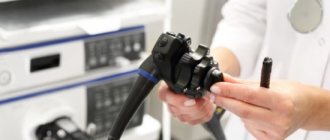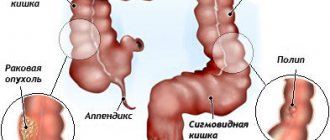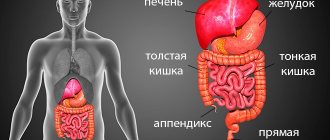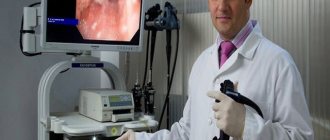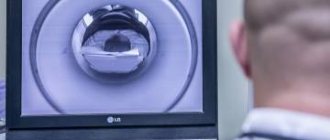What is this?
Irrigoscopy is a non-invasive diagnostic procedure that can be used to examine the large intestine. It involves the use of a contrast agent and x-rays, which makes it possible to assess in real time the condition of the intestinal wall, its properties, relief, the nature of the warehouses, as well as determine the presence of foreign bodies or neoplasms. This manipulation is painless and is not accompanied by the risk of injury, and the radiation dose that the patient receives is less than during a CT scan.
Advantages and disadvantages
The advantages of research using an endoscope: it is possible to identify even the most minor changes in tissues; all kinds of pathological formations are detected on the inner surface of the intestinal walls (anatomical defects, benign and malignant formations, polyps, internal fistulas).
It is possible to carry out the necessary therapeutic manipulations (elimination of bleeding, removal of polyps), the possibility of taking a tissue sample for subsequent histological examination. The examination, which takes 20 minutes, can replace many other diagnostic methods and still provide comprehensive information.
Disadvantages of endoscopic examination of the intestine:
- Inserting an endoscope through the rectum is an unpleasant and painful procedure that requires anesthesia.
- The preparatory period (diet and bowel cleansing from feces) is unpleasant for patients, which can lead to dehydration.
- The flexible probe has a certain diameter, so it is not always possible to overcome areas of stenosis.
- A colonoscope does not allow you to examine some hard-to-reach areas.
- If during the examination the specialist makes serious mistakes, then everything may end in abdominal surgery.
Differences between sigmoidoscopy and colonoscopy
After a colonoscopy, some patients may complain of abdominal pain and discomfort for 20 days. At the same time, with irrigoscopy, intervention in the body only involves the introduction of a barium suspension into the intestinal lumen, which leaves the body fairly quickly and does not cause any inconvenience, much less pain.
The advantages of intestinal irrigoscopy: diagnosis is considered relatively gentle and has a lesser degree of trauma to the body, allows you to examine the entire large intestine, including the cecum and the appendix, and identifies areas of narrowing in the intestine. The use of contrast makes it possible to evaluate the decrease in intestinal motility, loss of intestinal tone and the strength of spasms.
Disadvantages of irrigoscopy:
- presence of radiation exposure;
- there is no opportunity to take a tissue sample for histological examination or conduct targeted therapy;
- An allergic reaction to the injected contrast may occur.
Very rarely, patients notice a slight tingling or tingling in the intestines during the administration of contrast, but the patient forgets about these sensations 2-3 hours after the examination. Depending on the pathology, the information content of irrigoscopy and colonoscopy will differ.
During irrigoscopy, a person experiences nervous tension, which can worsen heart function and provoke a heart attack.
Technique
The duration of the examination is 30-40 minutes
. Before it starts, an x-ray is taken of the organs in a supine position, after which:
- The patient lies on his side, raises his legs to his stomach and puts his arms behind his back.
- The X-ray contrast agent is barium sulfate: which is first diluted with water and heated.
- The endoscopist inserts it into the rectum through a tube (in rare cases, the contrast is given orally). For barium to spread throughout all intestinal sections, you must wait about 2 hours. For uniform distribution, the patient will need to remain in a motionless lying position.
- Air is pumped into the intestines, straightening the folds, and several photographs are taken.
- Air is removed through the equipped valve, and the endoscope is removed.
Using double contrast, it is possible to diagnose colon cancer with high accuracy.
Advantages and disadvantages of methods
| Methodology | Advantages | Flaws |
| Irrigoscopy |
|
|
| Colonoscopy |
|
|
Differences from colonoscopy
Irrigoscopy or colonoscopy - which is better for the intestines? Before answering this question, it is necessary to highlight their main distinguishing features. This:
- Execution method
. Colonoscopy does not require the use of contrast or x-rays. Unlike competitive medical manipulation, it only uses a flexible probe with a camera. - Purpose
. Irrigoscopic examination is used exclusively for diagnostic purposes (except for intussusception in children), and during colonoscopy, polyps can be removed, bleeding can be stopped, or a biopsy can be taken.
Irrigoscopy and colonoscopy: what to choose
Irrigoscopy and colonoscopy have similar indications and contraindications, but the differences are obvious, for example, in the difference in equipment. The advantage of colonoscopy over non-invasive methods is that during the procedure it is possible to obtain data and remove tumors, polyps, take tissue for biopsy, and cauterize bleeding. A 100% accuracy level makes colonoscopy more informative and effective. Unlike irrigoscopy, colonoscopy provides information from the inside.
The main disadvantage of colonoscopy is the risk of damage to the intestinal walls by the probe and intestinal perforation. The contrast agent during irrigoscopy also causes a side effect. However, the doctor must compare the effectiveness; in each case, an individual type of examination is preferable.
When is sigmoidoscopy performed?
Indications for this procedure are:
- chronic diseases of the rectum;
- various digestive disorders, which manifest themselves as both diarrhea and constipation;
- hemorrhoids during pregnancy and the presence of intestinal bleeding;
- suspicions of malignant neoplasms not only in the intestines, but also in the prostate gland.
In addition, experts say that sigmoidoscopy is needed to prevent diseases - after 40 years it is recommended to do it once a year.
Thus, the indications for these two types of diagnostics will be approximately the same, since sigmoidoscopy and colonoscopy have similar goals. However, a colonoscopy is a more serious examination. Therefore, in some cases, before carrying out a sigmoidoscopy, a sigmoidoscopy is performed to assess the picture in general terms. As for diagnostic reliability, no method can provide 100% accuracy with the current level of equipment.
Features of colonoscopy
This examination is carried out with a special thin flexible probe. At its tip there is a video camera that transmits the image to the monitor. This procedure has great potential. During a colonoscopy you can:
- carefully examine the intestinal mucosa;
- detect malignant or benign neoplasms;
- find areas of inflammation and infection;
- identify the causes of certain pathologies;
- remove the polyp, cauterize the ulcer;
- stop internal bleeding in the large intestine;
- restore clearance in the area of narrowing;
- remove the sample for research.
Medical science does not stand still; colonoscopy is now being combined with ultrasound. This allows not only to detect a malignant neoplasm, but also to examine the structure of the tumor, its structure layer by layer. It is also possible to see nearby organs and assess their condition.
The big disadvantage of this examination is that it is painful. In some cases, the procedure had to be interrupted because the patient became ill or could no longer tolerate the pain. Although the colonoscopy took approximately 20 minutes, patient reviews were overwhelmingly negative.
But with the use of anesthesia, this problem was solved. The patient no longer feels pain and can relax. If your health condition does not allow the use of full anesthesia, then there is medicated sleep (sedation). The person is not sleeping, but is half asleep. At the same time, he can hear, talk, and understands what he is being asked to do.
Who is indicated for and what does irrigoscopy reveal?
Now it is clear how irrigoscopy differs from colonoscopy. The doctor must decide which procedure to prescribe. To make a more accurate diagnosis, irrigoscopy may be prescribed for the following symptoms:
- the patient experiences pain in the anus;
- there is discharge of blood, pus, viscous mucus in the feces;
- there is rectal bleeding;
- bothered by abdominal pain;
- chronic constipation or diarrhea;
- suspicion of neoplasms.
Irrigoscopy of the intestines reveals the following:
- the functional essence of the department under study;
- diameter, shape, size of the colon;
- the presence of fistulas, congenital anomalies, ulcerative lesions, neoplasms, diverticula, cicatricial narrowings;
- relief of the mucous membrane, elasticity, as well as the ability to stretch;
- operation and condition of the Bauhinium valve.
It is worth noting that irrigoscopy of the small intestine is not performed. For this part, endoscopy, ultrasound or computed tomography are used.
Briefly about the procedures
To understand the difference between colonoscopy and irrigoscopy, it is necessary to consider both methods. The essence of colonoscopy is to examine the inner surface of the intestine with a flexible endoscope, at the end of which there is a camera. This makes it possible to visually determine the condition of the mucous membrane, the presence of ulcers, and polyps.
The structure of the device allows you to remove polyps with a diameter of up to 1 mm and collect tissue for analysis during the procedure. Virtual colonoscopy is a non-invasive method for detecting formations from 5 mm in diameter. 2D/3D images are reconstructed from data obtained using a tomograph.
Irrigoscopy is a method based on the introduction of a retrograde (enema) X-ray contrast agent into the intestine, followed by an X-ray. Thanks to it, it is possible to determine the location, size of the intestine, its functioning, the condition of the ileocecal valve at the border with the small intestine, deformations due to ulcers, Crohn's disease. This method allows you to identify fistulas, diverticula, tumor formations, and developmental defects.
There are simple irrigoscopy and double contrast.
Who are the procedures contraindicated for?
Colonoscopy is not recommended for patients with Crohn's disease or ulcerative colitis in the acute stage due to the risk of perforation. The procedure is also not performed if peritonitis or exacerbation of diverticulitis is suspected. In case of serious disorders of the circulatory system (heart attack, heart failure, pulmonary failure), endoscopic interventions are life-threatening.
Due to anxiety, barium enema is contraindicated for patients with respiratory failure, heart and vascular diseases (stroke, heart attack, cardiovascular failure). Other contraindications for irrigoscopy are:
- severe diverticulosis;
- suspicion of intestinal perforation, its actual perforation (complication of an ulcer, tumor process);
- pregnancy;
- intestinal hypertrophy (viral etiology or due to taking certain medications);
- "acute" stomach;
- immobility, coma;
- suspicion of intussusception (blockage) of the intestine.
The last three points relate to double contrast irrigoscopy. In case of acute intestinal obstruction, the study is carried out exclusively with barium sulfate. The procedure in this case is called simple contrasting.
Preparation for the procedure
Nutrition
Before the procedure, the patient is advised to change his diet. It excludes foods that contain large amounts of fiber. It triggers fermentation processes that can disrupt the research. Foods rich in this substance include:
- bread;
- legumes (peas, beans);
- apples;
- potato;
- buckwheat grain.
Those foods that are poorly tolerated by the patient and can provoke an eating disorder are excluded from the diet. For example, it is not recommended to consume milk on the eve of the study for those patients who do not digest this product well.
The patient's menu consists of boiled foods (meat or lean fish), light soups, and water-based porridges. Eating butter, cheese, and eggs is allowed.
Laxatives
The main remedy for bowel cleansing before colonoscopy is Fortrans . This drug is a strong laxative. It is available in powder sachets, each of which must be diluted in 1 liter of water. The dosage of the drug depends on the patient’s body weight. The solution is prepared at the rate of: 1 sachet per 20 kg of weight. The dosage of Fortrans can be increased in the presence of chronic constipation, which requires more intense exposure.
Read more: Using laxatives to prepare for a bowel examination
The patient must drink each portion of the medicine within an hour. On average, the cleansing procedure includes 3-4 liters, which must be used in a short period of time - within 3-4 hours.
We recommend reading:
Endoscopic methods for examining the intestine: description and preparation
This effect is quite difficult for the body to tolerate, so there are a number of restrictions on the use of Fortrans. It is not recommended to use laxatives in elderly patients, as well as people with severe concomitant diseases.
Enema
Cleansing enemas (with a syringe, an Esmarch mug) are a mandatory component in preparation for irrigoscopy. The study requires complete bowel movement, which is achieved by lavage. The first enema is performed the evening before the procedure - approximately 12 hours before it. Repeated bowel cleansing is done several hours before the test.
Patient reviews
If you ask patients what is better - colonoscopy or irrigoscopy - they will most likely answer unequivocally that the procedure itself is simpler than irrigoscopy. But this is not the most important thing. The main thing is to more accurately identify problems and make a correct diagnosis. Therefore, it is better to listen to your doctor in this matter.
Colonoscopy may become more extensive. Reviews about the procedure are not so scary. The main thing is to prepare and tune in correctly. The modern procedure is performed under anesthesia and in rare cases the patient feels severe discomfort. Trust the experts.
5 minutes Author: Lyubov Dobretsova 7573
The intestine is an essential and longest organ of the digestive tract. Only its thick section can be up to 2 meters. Unfortunately, many diseases of this organ remain asymptomatic for a long time and are detected at a later and difficult to treat stage.
However, modern endoscopic and radiological diagnostic methods make it possible to detect and promptly treat most diseases of the colon in the early stages of development. But many patients have a reasonable question: what is better, irrigoscopy or colonoscopy?
Difference in methods
Thus, colonoscopy and irrigoscopy are different procedures. The first difference is in the use of equipment: the introduction of an endoscope during colonoscopy and the use of X-rays - irrigoscopy.
The next difference lies in the purpose of the procedure: irrigoscopy is diagnostic, colonoscopy allows simultaneous treatment. That is, if the pathology has already been identified, it is more advisable to perform a colonoscopy. Let's look at the difference between irrigoscopy and colonoscopy from the point of view of manipulation techniques.
During a colonoscopy of a previously prepared lying patient, the doctor inserts the flexible part of the device into the intestine, gradually moving it along the intestine. The length of the working part of the colonoscope tube is up to 145 cm, the diameter is about 11 mm, which allows, under good conditions, to examine the entire large intestine. The color image is displayed on the monitor.
During a colonoscopy, monitoring with an ultrasound machine is possible.
The equipment is equipped with a “cold” light guide, water and air supply systems, and an aspirator to remove foreign liquids that interfere with inspection. The movement of the colonoscope is controlled by levers on the control unit. If necessary, forceps, a loop, and other instruments are inserted through the biopsy channel to collect histology or for therapeutic purposes. Duration: 10-20 minutes.
During irrigoscopy, having previously prepared the intestines, the patient is placed in bed and a radiopaque barium suspension is administered by enema. A series of images are taken - irrigograms. After bowel movement, the images are repeated, examining the relief of the mucous membrane.
Further, for more detailed visualization, double contrasting of the intestine (filling with air) using the Bobrov apparatus is acceptable. In case of intestinal obstruction or perforation, iodine-containing contrast is used instead of barium.
Which is better and more informative: intestinal colonoscopy or irrigoscopy - becomes clear after a comprehensive study of each method. It is based on the purpose of the study.
Intestinal irrigoscopy - what is it?
If the doctor suspects any pathology in a hard-to-reach area of the intestine, then most likely he will prescribe another test. It is called intestinal irrigoscopy. What it is?
A technique for studying intestinal diseases (irrigoscopy) involves the use of x-rays. Before the procedure, the patient is prescribed retromanoscopy to examine the sigmoid and rectum.
Before starting irrigoscopy, the patient is asked to take barium sulfate, which will fill the intestines with a contrast solution. This will allow you to take an x-ray (irrigography). Doctors use it to analyze the situation. If there is little information, then air contrast is performed.
With irrigoscopy, it is possible to examine the large intestine, part of the small intestine, the cecum, and the appendix. The procedure allows you to detect diverticula, polyps, ulcers, fistulas, congenital pathologies, cancerous tumors, stenoses.
What is more informative – colonoscopy or irrigoscopy?
It is difficult to say clearly which method is more informative.
Colonoscopy is indispensable if a tumor is suspected, since in addition to a visual examination it makes it possible to perform a biopsy and remove the tumor. Irrigoscopy allows you to assess the condition of the mucosa along its entire length and in areas inaccessible to the endoscope. X-rays can easily identify areas of narrowing of the digestive tract.
Each of the methods considered has its own indications, advantages and disadvantages. The choice of diagnostic method is individual and depends on many factors: the patient’s age and concomitant diseases, the intended diagnosis, possible contraindications.
Indications for colonoscopy and sigmoidoscopy
When choosing one type of diagnosis or another, the patient’s complaints and the clinical picture as a whole are taken into account.
Indications for colonoscopy are:
- bleeding and mucus from the anus;
- the presence of blood in the stool;
- severe loss of body weight for no apparent reason;
- inability to diagnose the disease using other methods such as ultrasound and computed tomography;
- decrease in hemoglobin level in the blood;
- the appearance of pain in the intestines (that is, in the lower abdomen);
- prolonged stool disorders.
In addition, sometimes this diagnosis is carried out for preventive purposes. And in older people it is used for inflammatory bowel diseases.
Consequences of the procedure
If the procedure is performed by a qualified, experienced specialist, and the patient complies with all the doctor’s recommendations, the likelihood of complications developing is minimal. The following reactions may develop:
- Discoloration of stool is a natural reaction caused by exposure to barium suspension.
- If the contract substance is administered in excess, feelings of pain and discomfort may occur.
- Constipation. To eliminate them, it is recommended to use cleansing enemas or medications with laxative properties.
- In isolated cases, the development of serious side effects was reported: barium embolism, perforation of the intestinal walls, leakage of contrast agents into the retroperitoneal space, abdominal cavity. If any unpleasant symptoms arise after diagnosis, it is recommended to immediately seek advice from a specialist.
Among the main advantages of irrigoscopy, it is worth noting its high information content and the ability to accurately assess the functional state of the digestive organ.
The examination is carried out for a fee. The average price for intestinal irrigoscopy is 4,500 rubles. The cost may vary depending on the type of clinic, the qualifications of the doctor, and the manufacturer of the equipment used.
5 minutes Author: Lyubov Dobretsova 7584
The intestine is an essential and longest organ of the digestive tract. Only its thick section can be up to 2 meters. Unfortunately, many diseases of this organ remain asymptomatic for a long time and are detected at a later and difficult to treat stage.
Carrying out a colonoscopy procedure
Does colonoscopy require prior anesthesia? Reviews from patients say that the procedure is unpleasant and therefore, to facilitate the examination, the doctor first administers local anesthesia. If colonoscopy is performed on children under 12 years of age or on people with a low pain threshold, general anesthesia may also be used.
How is the procedure performed? The patient must prepare in advance (more on this below). You need to lie on your side and pull your legs towards your stomach. The specialist inserts an endoscope into the anus. In order for the intestinal walls to stretch a little, a small amount of air is introduced at the same time. The camera of the device transmits to the monitor an image of what is happening inside. Here, a competent doctor should assess the condition of your intestines. Sometimes the patient is asked to turn over. The examination lasts from 10 to 15 minutes. The device allows you to evaluate the intestines at 1.5 meters.
For several days after the examination, it is recommended to maintain proper nutrition so as not to injure the walls. It is better to avoid hard, rough foods, smoked, spicy foods and alcohol.
If the patient is well prepared for the test and it is performed by a professional, then colonoscopy will be a safe and effective procedure.




